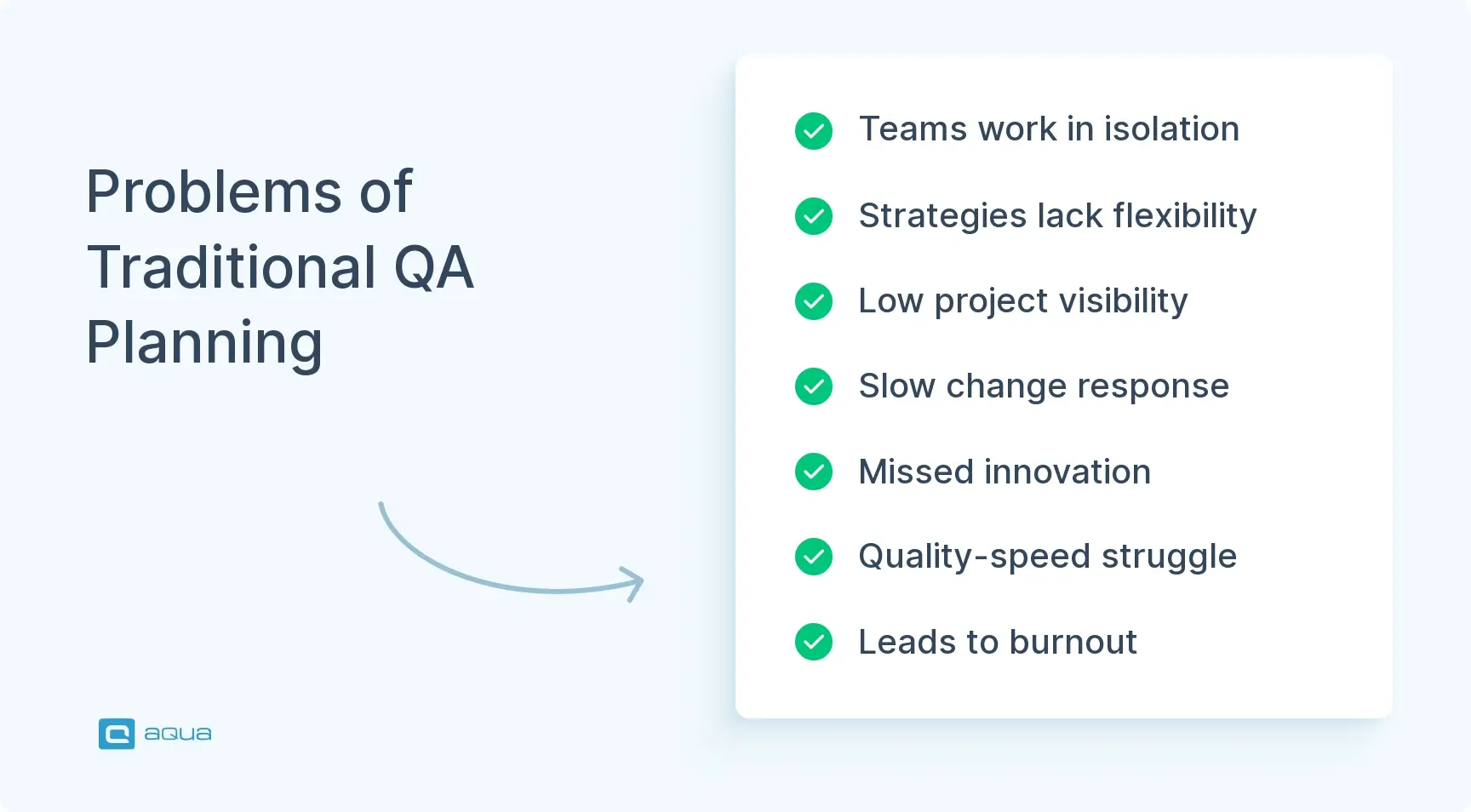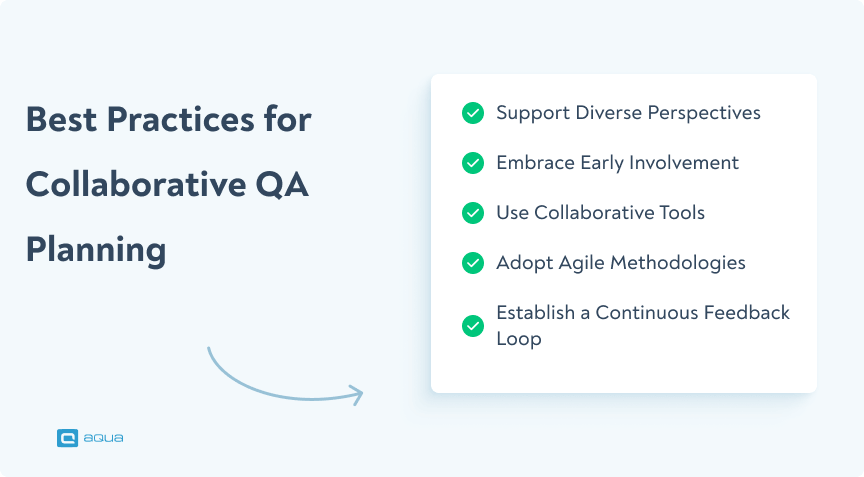A project’s success depends entirely on effective collaboration between QA teams and the rest of the development team. To revolutionise QA planning, enhance software quality, and speed up development, we’ll look at ways to encourage teamwork, promote open communication, and use the right resources. So, let’s start, shall we?
What is traditional QA planning and its pitfalls?
Before diving into the methods for successful collaboration in QA, let’s begin by unravelling the concept of traditional QA planning and examining its shortcomings.
QA planning is strategising and organising quality assurance activities to ensure that software or products meet predefined standards and requirements. Isolated QA processes create a mess. Feedback crawls at snail pace, teams duplicate work without realizing it, and somehow the final product misses what customers actually want. Pick one weekly touchpoint where your QA team connects with product and dev. You’ll spot redundancies within days and catch alignment issues before they derail your timeline.
Below are the limitations of traditional QA planning and how they impede your progress:
- Isolated Teams: During traditional QA planning, developers, testers, and stakeholders are frequently divided into separate compartments. This separation often blocks effective communication and collaboration in QA planning by hindering the flow of ideas and information.
- Inflexible Strategies: Traditional strategies often struggle to keep up with dynamic development environments. This inflexibility can cause delays as your plan must align with evolving requirements.
- Lack of Visibility: Teams in conventional QA frameworks frequently need a clearer understanding of the bigger picture. Because of this lack of visibility, it can be challenging to understand how individual efforts contribute to overall project goals. Small details are of the essence, as they can hinder the bigger picture in the end massively.
- Slow Response to Changes: Traditional methods respond slowly to changing requirements. This lack of agility makes it hard to pivot, impacting project timelines and quality.
- Missed Opportunities: Due to traditional QA’s isolated nature, innovation opportunities are frequently overlooked, limiting collaboration and exploration of creative solutions.
- Quality vs. Speed Dilemma: Balancing quality and speed in traditional QA will take more time and effort than you expect. So, the QA team’s focus frequently shifts between the two, making delivering high-quality software on time challenging.
- Frustration and Burnout: Team members may become frustrated and burn out due to the isolation present in conventional methods. Working alone without a broader sense of purpose can be discouraging and demotivating.
Although this method is not completely dysfunctional and might work for your company for some time, it is important to be aware of its limitations and consider more modern and efficient approaches to ensure long-term success. And this brings us to the ultimate solution to the problem we will discuss in the following paragraphs.

“Effective quality management not only creates customer trust and loyalty but drives continuous improvement and innovation.”
Collaborative QA Planning and its key elements
Now that we know what holds your team back from traditional methods let’s introduce our saviour: collaborative QA planning. What makes this planning method innovative and different from traditional, and why should you employ it?
To overcome the barriers of old-fashioned QA planning, you need fundamental elements that form a more collaborative and engaging approach. They improve quality assurance and cultivate a strong sense of connection among your team:
- Adaptability: Just as the hero of a story must adapt to changing circumstances, QA planning must be flexible enough to evolve with the project’s needs. The ability to pivot when required ensures success in dynamic environments.
- Unified Vision: Mutual vision in a team encompasses shared goals, objectives, and a collective understanding of the project’s purpose. This shared vision is the cornerstone for effective teamwork, aligning everyone towards a common goal and driving the project’s success.
- Open Communication Channels: Open and transparent communication fosters trust among team members. Similarly, in collaborative QA planning, transparent communication is the thread that weaves teams and improves QA-developer relationships.
- Data-Driven Insights: In collaborative QA planning, data-driven insights serve as helpful tips, guiding decision-making, identifying shortcomings earlier, and enhancing overall quality through shared information and teamwork.
- Continuous Learning: Collaborative QA planning encourages a culture of continuous learning, which contributes to the team’s collective growth and improvement. Each experience forms a basis for success in the future.
- Empowerment: A sense of empowerment includes commitment, dedication, ownership, and accountability among team members. When team members feel empowered, they take ownership of their work and are dedicated to delivering high-quality results.
In the realm of collaboration, effective QA planning is the cornerstone of success. It’s about bringing your team together, ensuring tasks align with deadlines, and fostering transparent communication. However, this process can be complex and fragmented.
This is where aqua cloud, the test management solution your QA team has been searching for, comes into play. Being 10 years in the market, aqua integrates with these collaborative elements, enhancing teamwork by bringing structure, visibility, and traceability to your QA work. It leverages the power of AI to save time and remove any pain from testing, ensuring that your team operates seamlessly, transparently, and efficiently. By using aqua, you’re not just implementing a tool; you’re revolutionising your approach to QA. Discover how aqua can transform your collaborative QA process, and you’ll see why it’s the solution you’ve been searching for.
Elevate your QA management to a new level
The Power of a Shared Language and Cross-Training
Getting your QA and dev teams speaking the same language is a total game-changer, and it’s simpler than you think. When your developers actually understand QA terminology (and vice versa), everything clicks into place faster.
You need to get developers involved in test planning sessions, and bring your QA folks to code reviews. This cross-pollination nearly doubles team efficiency because people start anticipating what the other side needs before problems hit.
Adopt Gherkin syntax for your acceptance criteria. It forces everyone to write requirements in the same format, whether you’re a coder or a tester. Plus, it catches those sneaky misunderstandings before they become bugs.
When your QA specialist understands the technical constraints and your developer knows testing priorities, hand-offs become seamless. No more playing telephone between departments or scrambling to fix things last-minute.
Best Practices for Collaborative QA Planning
Now that you know the key elements of collaborative QA planning, let’s move on to our final step towards shifting your whole QA process. Just as agency-client relationships thrive on communication, trust, and shared goals, so will your QA process flourish when you embrace these collaborative principles within your team.
In crafting collaborative QA planning, we start on a journey that uncovers the best practices illuminating the path forward. These practices act like pivotal moments in your QA process, helping you meet your tasks, releases, and deadlines effectively while ensuring your work aligns with the organisational goals.
- Support Diverse Perspectives within your QA team to bring fresh insights and innovative ways to approach quality assurance. It will also help you in the process of identifying and resolving bugs comprehensively.
- Embrace Early Involvement of testers and developers ensures that quality is woven into your project’s core, resulting in a more effective QA planning process.
- Use Collaborative Tools that are selected carefully to ensure effortless communication and cooperation in your team. They are like a bridge, connecting team members and enabling them to work harmoniously by supporting cooperation.
- Adopt Agile Methodologies to offer a flexible framework that enables real-time adaptation and evolution of your QA processes. This adaptability allows the QA plan to react rapidly to evolving project requirements, emerging issues, or shifting priorities.
- Establish a Continuous Feedback Loop that involves creating a systematic process for collecting, analysing, and applying feedback throughout the project’s lifecycle. This ongoing process enables the team to make improvements and adjustments, which leads to a more effective and efficient QA process.
These key parts of a strong QA strategy come together to ensure quality.
You’ll want to get your cross-functional teams talking early — not just during sprint reviews. Real collaborative QA planning means your developers, testers, and product folks are throwing ideas around from day one. Have everyone define what “done” looks like together. Using this approach, you’ll see quality issues drop by nearly half because everyone’s actually on the same page.
Just grab your team next week and spend 30 minutes mapping out who needs what information when. It’s when your QA strategy becomes everyone’s strategy, not just something bolted on at the end.

Data-Driven Collaboration and Living Quality Dashboards
Skip the guesswork; your QA planning needs real data to work. Build a shared dashboard that tracks defect escape rates, build health, and test coverage where everyone can see it. This simple move transforms abstract quality discussions into concrete decisions.
Set up weekly defect triages where the whole team reviews patterns together. You’ll spot recurring issues faster and prioritise fixes based on actual impact rather than whoever shouts loudest. Focus on metrics that matter – which app sections break most often, where flaky tests kill confidence, or what changes correlate with bugs.
When developers see quality data daily, they start writing more defensive code automatically. Your QA strategy becomes everyone’s responsibility, not just the testing team’s problem.
Conclusion
A truly effective QA planning process is not merely a series of steps; it’s a captivating story of collaboration, adaptability, and user-centric excellence. By incorporating diverse perspectives, early involvement, collaborative tools, Agile methodologies, automated testing, and a continuous feedback loop, you forge a path to software quality that resonates with your team and your audience. A single solution that will streamline your QA process while keeping your team on the same page will help you achieve the excellence you strive for.
To follow the elements of the collaborative approach and streamline your quality assurance efforts effortlessly, consider leveraging aqua cloud. With its intuitive, AI-driven platform designed to enhance collaboration and 100% traceability, aqua is your trusted partner in crafting the next chapter of your QA story. Bottleneck-free collaboration, flexible reporting, and unparalleled customisation are your gateway to a new level of efficiency and teamwork. Take a step toward a future where quality assurance becomes a seamless part of your narrative and your audience experiences the excellence you offer firsthand.
Make your QA management effortless with a click


















